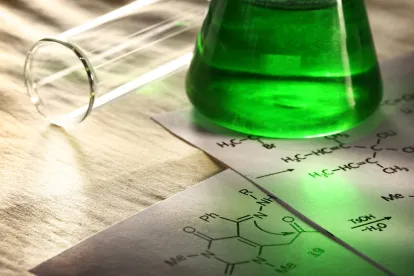On November 30, 2016, the USPTO Patent Trial and Appeal Board (PTAB) held oral hearings in two different inter partes proceedings involving the Biogen Tecfidera® patent with the latest expiation date. First, it heard arguments in the Inter Partes Review (IPR) brought by Kyle Bass and the Coalition for Affordable Drugs, and then it heard arguments in an interference where Biogen MA Inc. is the junior party against Forward Pharma A/S. While any IPR involving an Orange Book-listed patent attracts a lot of attention, the concurrent interference proceeding makes this case both more complicated and more interesting.
The Tecfidera Patent At Issue
The Tecfidera® patent at issue is U.S. 8,399,514, directed to methods of treating multiple sclerosis. Claim 1 recites:
1. A method of treating a subject in need of treatment for multiple sclerosis comprising orally administering to the subject in need thereof a pharmaceutical composition consisting essentially of
(a) a therapeutically effective amount of dimethyl fumarate, monomethyl fumarate, or a combination thereof, and
(b) one or more pharmaceutically acceptable excipients,
wherein the therapeutically effective amount of dimethyl fumarate, monomethyl fumarate, or a combination thereof is about 480 mg per day.
The ‘514 patent stemmed from a PCT application filed February 7, 2008, and claims priority to a U.S. provisional application filed February 8, 2007. The 20-year term of the ‘514 patent expires February 7, 2028.
Interference 106,023
Forward Pharma copied claims from the ‘514 patent into its U.S. Patent Application 11/576,871, to trigger an interference, which was declared as Interference 106,023 on April 13, 2015. The interference “count” largely parallels claim 1 of the ‘514 patent, but specifies treating a “human.”
Forward Pharma was named as the senior party based on its earlier priority claims to PCT/DK05/00648 filed October 7, 2005, and Danish application PA2004 01546, filed October 8, 2004. Since Biogen is the junior party, it has the burden of proof.
Biogen appears to be focusing on two main arguments in the interference:
-
Forward Pharma’s application does not provide adequate written description support for its claims
-
Biogen has an earlier date of invention based on its conception in February 2004 and diligence until its actual or constructive reduction to practice
Forward Pharma appears to be focusing on three main arguments in the interference:
-
Biogen’s patent does not provide adequate written description support for the recited dose of 480 mg
-
The ‘514 patent is anticipated by Forward Pharma’s PCT application, which was published in April of 2006, and Biogen has not met its burden to swear behind it.
-
Forward Pharma has an earlier date of invention based on its provisional application.
While most interference proceedings are conducted in two phases, with a first “motions” phase addressing issues pertaining to patentability (i.e., written description) and a second “priority” phase addressing relative dates of invention (i.e., conception, diligence, reduction to practice), the PTAB consolidated the stages in this case and took evidence on all issues.
IPR 2014-01993
The IPR resulted from the second petition that Kyle Bass and the Coalition for Affordable Drugs filed against the ‘514 patent. (The first was denied.) The PTAB instituted proceedings based on three grounds of unpatentability:
-
Claims 1–6, 8–16, and 20 of the ’514 patent as unpatentable under § 103(a) over Kappos 2006, Clinical Trials, Joshi ʼ999, and ICH Guideline.
-
Claim 7 of the ’514 patent as unpatentable under § 103(a) over Kappos 2006, Clinical Trials, Joshi ʼ999, ICH Guideline, and Joshi ʼ992.
-
Claims 17–19 of the ’514 patent as unpatentable under § 103(a) over Kappos 2006, Clinical Trials, Joshi ʼ999, ICH Guideline, and Begleiter.
Several of the asserted references only qualify as prior art if the ‘514 patent is not entitled to the benefit of the provisional application. In instituting the IPR, the PTAB noted that Biogen’s specification only mentions the 480 mg dose as the end point of a range:
For example, an effective dose of DMF or MMR to be administered to a subject orally can be from about 0.1 g to 1 g per pay, 200 mg to about 800 mg per day (e.g., from about 240 mg to about 720 mg per day; or from about 480 mg to about 720 mg per day; or about 720 mg per day). For example, the 720 mg per day may be administered in separate administrations of 2, 3, 4, or 6 equal doses.
The PTAB cited Atofina v. Great Lakes Chemical Corp., 441 F.3d 991, 1000 (Fed. Cir. 2006), for the proposition that “the disclosure of a range is not a disclosure of end points of the range any more than it is of each of the intermediate points.” Biogen has argued against the PTAB’s application of that case in the written description context, since the court in Atofina was addressing whether the end points of a prior art range constituted a disclosure of specific species within the scope of a “slightly” overlapping claimed range under 35 USC § 102.
A Must-Win For Biogen
While the interference and IPR raise overlapping issues–such as whether the claims of the ‘514 patent are supported by the provisional application–it is not difficult to imagine scenarios where Biogen prevails in the interference but not the IPR, or vice versa. However, Biogen needs to prevail in both proceedings in order to preserve the ‘514 patent. Because the IPR was instituted March 22, 2017, we should have a decision in at least that proceeding by March 2017.




 />i
/>i
